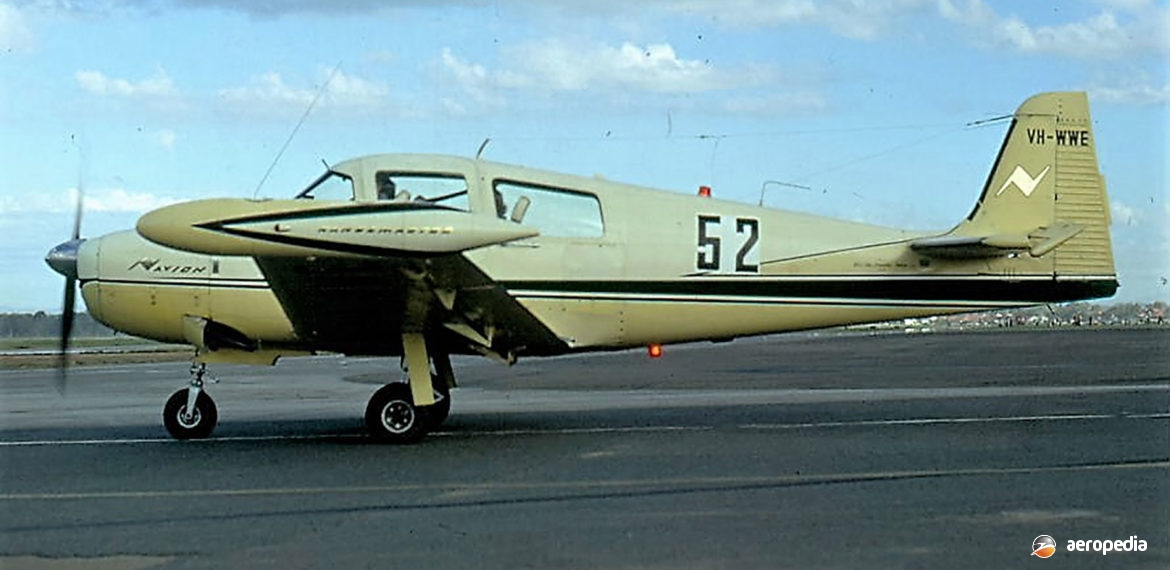Photograph:
Rangemaster VH-WWE (c/n 4-2403) at Benalla, VIC in 1990 (David C Eyre)
Country of origin:
United States of America
Description:
Five-seat long-range touring cabin monoplane
Power Plant:
One 194 kw (260 hp) Continental IO-470H six-cylinder horizontally-opposed air-cooled engine
Specifications:
- Wingspan: 10.6 m (34 ft 9 in)
- Length: 8.38 m (27 ft 6 in)
- Height: 2.54 m (8 ft 4 in)
- Wing area: 17.13 m² (184.34 sq ft)
- Max speed: 290 km/h (180 mph)
- Cruising speed at 75% power: 278 km/h (173 mph)
- Cruising speed at 65% power: 259 km/h (161 mph)
- Initial rate of climb: 329 m/min (1,080 ft/min)
- Service ceiling: 6,248 m (20,500 ft)
- Max range: 2,990 km (1,858 miles)
- Fuel capacity: 341 litres (75 Imp gals)
- Empty weight: 884 kg (1,950 lb)
- Loaded weight: 1,504 kg (3,315 lb)
History:
When first seen in Australia, the Navion Rangemaster was publicised as having the longest range of any single-engine light aircraft then available. To prove the point, the two aircraft which were to appear on the Australian register were both delivered by air from the USA.
The Rangemaster was designed and built by the Navion Aircraft Company at Galveston, Texas as a development of the original Navion 205, of which some 2,800 were delivered, which had been designed by North American and built by the Ryan Aeronautical Co. Both Ryan and North American produced military variants as the Ryan Navion, the type being used by the USAF and the US National Air Guard as the L-17. It was evaluated by the US Navy at Pensacola, Florida in 1953 but was not ordered. Production concluded in the mid 1950s due to the manufacturer’s commitment to producing military equipment for the Korean War. Design and manufacturing rights were then obtained by Navion Aircraft Co.
Initial model was the 205 which was a four-seat monoplane powered by a 154 kw (205 hp) Continental E-185-3 engine, or a 194 kw (260 hp) Lycoming GO-435-C2 engine. Construction was of all metal and all components of the airframe were individually sprayed with zinc chromate compound prior to assembly. Whereas the Ryan Navion had a sliding canopy, the Rangemaster had a conventional fixed cabin top and access was by way of a large door on the port side. An innovation was the fitting of double disc Goodyear brakes. The cabin was large and the single rear seat could be folded down or removed to increase the luggage area at the rear of the cabin.
The Navion G-1, as it became known, retained the model 205 wing, undercarriage and basic fuselage outline, but was in fact a new design taking advantage of more recent technology. The prototype of the Rangemaster G-1 was flown for the first time on 10 June 1960, with deliveries of production aircraft beginning during the following year. One main model of the Rangemaster was built. Later production aircraft differed from early aircraft only by having redesigned and smaller vertical tail surfaces.
The Rangemaster was described in 1962 as having excellent short-field capabilities, high cruising speed, being able to take off in less than 122 m (400 ft) and land in less than 91 m (300 ft). Standard aircraft had the fuel-injected Continental IO-470H of 194 kw (260 hp) driving a McCauley constant-speed hydraulic propeller with a Woodward governor. Later the TSIO-520 engine of 216 kw (290 hp) was installed, this providing full power from sea level to 4,877 m (16,000 ft). A single axis, two control autopilot built by Aircraft Radio Corp was available. Early in the aircraft’s production life the Company announced it would be moving production to a new facility at Harlingen, Texas, some parts being made in Phoenix, Arizona.
Two Rangemasters were imported to Australia. The first was delivered to the Australian distributor, Worldwide Aeronautical Services Pty Ltd of Bankstown, NSW by an American ferry pilot, this aircraft becoming VH-WWE (c/n 4-2403), and is still extant in Victoria, being initially registered in November 1962. The second aircraft VH-WWL (c/n 4-2439) was registered in February 1964 and at one stage was registered to Carnarvon Air Pty Ltd of Roma, QLD. It was destroyed in a hangar fire at Roma on 13 November, 1966 with other aircraft.

